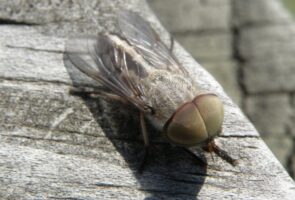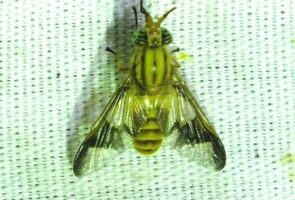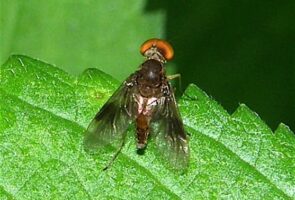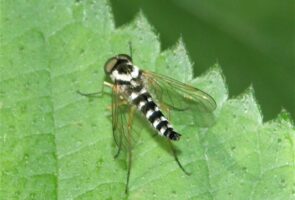Biting Flies / Snipe Flies
Biting Flies here include Horse Flies, Mosquitoes, Snipe Flies and Black Flies.
Horse Flies (Tabanidae) comprise about 350 species in 30 genera in North America. Females of most species are blood feeders. The males sip nectar at flowers and hover to attract females. Both sexes have large eyes, but the eyes meet on top of the head on males and are separated on females. Typically the females lay eggs in dense masses on leaves above the water. The larvae usually live in water or wet mud and are predatory on other insects and worms. Mosquitoes (Culicidae) are universally known as pests and disease carriers. Only females feed on blood. Most feed on birds and other animals. Males have plumose antennae which aid in detecting the whine of the female’s wingbeat. The adults provide a valuable food resource for bats, birds, frogs, dragonflies and spiders. The larvae are aquatic and are food for fish and other predatory aquatic insects. Snipe Flies (Rhagionidae) are represented with about 55 species in North America. Both the larvae and adults are predatory. The larvae live mostly in decaying wood and the adults are usually seen on foliage. Black Flies (Simuliidae) are found throughout North America of which there are 255 species in 13 genera. Adults are black to various shades of gray or yellow; thorax shiny, strongly convex, giving a humpbacked, gnat-like appearance, small head with large round eyes and short 11-segmented antennae. Larvae are brown, gray, or black with light brown head; body cylindrical, somewhat club-shaped; head with prominent pair of mouth brushes used for filtering food from running water.
Disclaimer: The content of NatureSearch is provided by dedicated volunteer Naturalists of Fontenelle Forest who strive to provide the most accurate information available. Contributors of the images retain their copyrights. The point of contact for this page is: Loren Padelford.
-
 BLACK HORSE FLY
BLACK HORSE FLY
-
 FULVULUS HORSE FLY
FULVULUS HORSE FLY
-
 STRIPED HORSE FLY
STRIPED HORSE FLY
-
 CHRYSOPS DEER FLY
CHRYSOPS DEER FLY
-
 CHRYSOPILUS QUADRATUS
CHRYSOPILUS QUADRATUS
-
 ORNATE SNIPE FLY
ORNATE SNIPE FLY
-
 STRIPED BLACK FLY
STRIPED BLACK FLY
